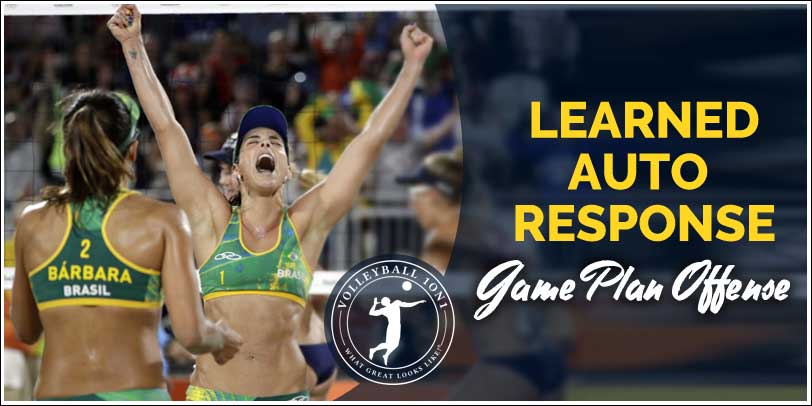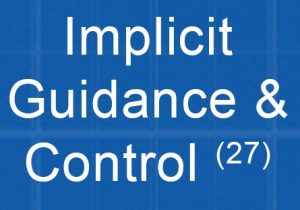This article and video series reviews how beach volleyball players who develop a “Game Plan Offense” can takes advantage of “Learned Automatic Response” and “Implicit Guidance” to beat opponents and overcome physical disadvantages on the court. The tactic I will discuss were used quite successfully in the 2016 Olympics to defeat Kerri Walsh Jennings and April Ross.
This Olympic win is testament in my opinion on how smaller less athletic teams can follow similar tactics to beat taller, stronger and more athletic teams. I see this becoming the standard for beach volleyball coaching in the near future.
Importantly similar tactics can also be used for indoor volleyball and these tactics are already being taught at out Volleyball1on1 camps and clinics.
Military Tactics Applied to Beach Volleyball
In war if you are fighting a stronger opponent you will never attack them head on. Rather you will choose your battle field and attack where they are weakest, not ready, and need to react to your attack vs. being prepared for the attack. Yet in beach volleyball most teams on offense do not consider this and attack their opponent in a straight line where the opponent is waiting and prepared.
Just like war the team on offense can often choose and control the battle field or attack location.
If the serve receive offense team controls the pass they control the offense and where they attack along the net. The first point of attack I am going to review in this post and the area I think the most effective when in system is the middle middle location with a back set.
For this example I will review this from the ideal of right-handed players playing left side and left-handed players playing right side.
Important notes related to and understanding our Volleyball1on1 Coaching Language and Culture can be found below. Terms like “middle middle” and “white set” are explained as well as points related to the OODA Loop.
White – Back Middle Middle Set and Attack
The “White” set is a back set, where the passer passes forward, in front of their inside leg and runs an attack on a back set, through the middle middle location. This attack along the net and set offers many advantages in our opinion over a regular up and down set outside front or outside middle.
Benefits include:
- The defense is attacked where they are weaker or even weakest.
- The defense needs to move their defense, both blocker and defender to the new attack location. (Chris explains this)
- As the defenders move, they become easier to read and “orientate” in the OODA Loop.
- Because the defenders are easier to “orientate,” implicit guidance” or “learned auto response” can be developed with training resulting in players moving through the OODA Loop faster or essentially only having to OOA, essentially illuminating the decision process.
- Because the defense is moving they suffer from “response complexity” which reduces their defense effectivity.
- Because the defense is moving they are less effective at reading as their heads are not still and only focused on the task of reading.
- Because the defenders are just trying to move into the correct position they are less likely and successfully able to run defensive plays like a 3 block 4 block.
- Because defenders are running fewer defensive plays like the 3 and 4 block on defense, “hicks law” has less of an influence on the offensive hitter, thus resulting in greater rhythm and hence greater speed through the OODA Loop for the offense team. This in turn translates into better speed at “reading,” and slowing the ball and game down for the offense and attacker. (Ben reviews this)
- Because the defending blocker is moving to start, they are less effective at blocking line to middle as they cannot adjust as effectively to the set location or what they read the attacker doing. Blockers will tend to only block line or only block angle.
- Because the blocker is moving this will often create more opportunities to successfully attack on two or even just set the ball over the net on two. It is surprising how many kills will happen in women’s volleyball where the attacker runs a back set and the setter just sets the ball forward for a kill on two.
- This increased threat of a second ball attack further increases “Hick’s law,” and “response complexity for the defense” thereby slowing their ability to move through the OODA Loop.
- The momentum of the set tends to lead to the ball being more often in front of the players hitting shoulder.
- Sometimes the blockers mind freezes when running up to block after serving and they pull leaving open a free net! At the younger level and in women’s volleyball this happens allot. (See below video with Branden)
Implicit Guidance and Control – Learned Auto Response.
(Point #27 from OODA Loop Volleyball Vision Coaching Blueprint)
The ability to bypass the decision-making process by already knowing what action to take can help players significantly increase their speed in the OODA Loop. Boyd called the process of bypassing steps of the OODA loop “implicit guidance and control.”
Implicit guidance and control is an unconscious pre-planned physical response to a known stimulus, which is often referred to by psychologists as a “learned automatic response.”
“Learned automatic response” has been successfully applied in many other sports but has gone unsuccessfully trained in United States Volleyball because of the prevalent culture and coaching philosophy of: “The game teaches the game.”
This in my opinion has resulted in less controlled practice where coaches teach pre-planned physical response to a known stimulus or “learned automatic response.”
Pre-Planned Physical Response to a Known Stimulus
Although volleyball is chaotic in nature where only the serve players have 100% control of, most plays start with a pass or a dig where players can exert control and set up “known stimuli.”
For example in beach volleyball if you have a good pass in-front of you on the net, most teams will block and most often block line. This in my opinion is a “known relatively controllable stimuli.”
Once the team on offense creates “known relatively controllable stimuli,” this creates and opportunity for them to control their offense and set up a situation for “learned automatic response” on offense.
Learned Automatic Response” on Offense in Action
On a white set learned automatic response becomes a pretty easy due the ability to quickly and easily “Orientate” the opponents defense. Not only do our eyes pic up movement more successfully, we are able to process that movement more successfully than stationary objects with our peripheral vision.
This is because peripheral vision pics up movement more successfully than stationary objects.
In most cases the defense will go to a line block on a white set. This leads to 3 main easy shots:
- Line chip shot over the block.
- Hard cross body hit back into the line in the form of a hard hit.
- Sharp cross body hit into the line short in the form of a cut shot.
In the case where the defense blocks angle, this leads to allot of problems for the defense.
- Firstly the block is very easy to read and the hitters momentum is all going into their power shot line leading to a very hard driven ball which is very difficult to stop. Also, this set / ball travels to the line past the hitter shoulder which allows this hard hit shot to be performed very easily. This ball can also be hit not just line but also seam and is very difficult to block or dig for this reason. (See the video with the Brazilian’s)
- If short line is very easy to see and hit if the blocker goes angle.
- The cutback short and deep angle are also both very easy to hit on a angle block either around or over the block.
I have included some videos of this in action.
Implicit Guidance and the Players Thoughts:
This video features:
Ben Vaught – U21 USA
Joel Blocksom – Olympic hopeful Japan
Chris McDonald – AVP Beach Volleyball Player
Implicit Guidance Drill:
Branden in Action Learning the White Set
Branden timing is too early and he gives it away to early at the moment. We are working on this and I will try post more videos as he gets better at it!
The Brazilian’s in action:
Play 1 – Line shot by lefty over the block
Play 2 – Hard line hit with the blocker blocking ball. Notice how easy it is to hit line unless the blocker commits to the line block because of how the set carries to the hitters hitting shoulder.
Play 3 – Easy line shot over the line blocker
Play 4 – Easy cut shot when the blocker is line and the defender is middle. The ball traveling across the body onto the shoulder makes the cross-body cut shot very easy to hit.
Play 5 – Another hard line hit with the blocker blocking ball. Notice again how easy it is to hit line unless the blocker commits to the line because of how the set carries to the hitters hitting shoulder.
This is how the Brazilian’s could sideout so effectively on Kerri and April in the 2016 Olympics.
In review, setting up your offense and attacking where your opponent is weakest, not ready, and need to react to your attack vs. being prepared for the attack offers many advantages over attacking in a straight line. I believe as this is practiced and executed more this will become the norm and a new age of beach volleyball offense will be introduced.
If you are a beach club program or a high level professional team or an international team looking to add this to your program contact me here!
Andorvolleyball1on1@gmail.com or (310) 435-5840.
Indoor Volleyball Applications: The information I shared in this article can be applied successfully to indoor volleyball. This past season we had a number of high schools and clubs use this information and run new “Game Plan Offenses” based upon it. I will do my best to post some new content related to this in the next few weeks.
Important Notes Related to Our Volleyball1on1 Coaching Language:
- We describe Volleyball1on1 Systems of Beach Volleyball Play on the court as “What Great Looks Like!” ®
- “What Great Looks Like!” ® on the court for beach:
- We Serve In and Tough
- No Hitting Errors
- We Pass the Ball Tight
- Hittable Balls
- We Take Out the Trash
- Relentless Pursuit Defense
- Game Plan Offense
- Game Plan Defense
© 2017
For (#7) Game Plan Offense:
- We divide the net into 5 locations on offense – Outside Front, Middle Front, Middle Middle, Middle Back, Outside Back. This is the same for both players and relative to the player.
- The most effective locations to attack from on a good pass is: Middle Middle, Outside Front and finally Outside Back in that order in our opinion and based upon the science we have seen.
- We run 3 regular sets: Outside, Middle, Up and down.
- We run 6 play sets: Green – Fast Outside, Blue – Up and Down Front Two in the middle, White – Back Up and Down Two, Red – Fast Outside Back Set, Black – Fake White for a Blue, and finally a Go – A Lob inside set 5-7 feet inside the pin like a 3-2 indoor just a little higher.
- When I refer to a 2 set it is higher than a regular 2 set indoor. It can be 4-10 feet above the net. Most important is the location and that the ball is set in more of an up and down trajectory.
- Our goal is to force “Hicks Law” and “Response Complexity,” on offense by running plays and attacking on two.
For (#8) Game Plan Defense:
- Our top goal is to force “Hicks Law” on defense thus slowing the attacker’s reaction time in the OODA Loop.
- Only 10-15% of hard driven attacks are converted for points so as a result our goal is to try block most hard driven ball attacks and dig most shots. We are more block hits and dig shots focused as a team and individually. This means our blocker and defender are positioned more middle in the court.
- We have 10 blocking calls to force “Hicks Law” and play into our game plan defense of blocking hard driven balls while digging shots.
- Line – 1 Finger.
- Angle – 2 Fingers Spread.
- Angle to Line – 3 Fingers.
- Line to Angle – 4 Fingers.
- Ball – 5 Fingers.
- Seam – 2 fingers together.
- Angle with Line Defender Waiting – 2 Fingers Spread with Pinkie.
- Double Line – Index and Pinkie Finger.
- Double Angle – Vulcan Sign.
- Line to Ball – Hang Ten Sign.
- Terms related to the OODA loop can be found here: https://www.volleyball1on1.com/volleyball1on1-ooda-loop-volleyball-vision-coaching-blueprint-and-vision-training-for-sports-paper/






